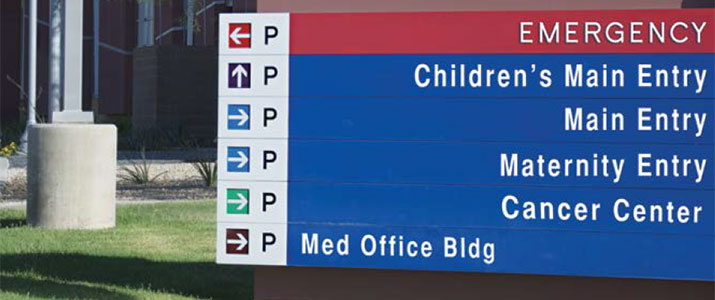
The Prescription for Curing ID Badge Ills
Increased control and advanced reporting are critical for a safe facility
- By Ann Geissler Timme
- Jun 01, 2014
 Many hospitals are finding it necessary to increase the number of
access controlled openings in their facilities. Whether it’s due
to increased violence, additional privacy requirements or emergency
preparedness, they are finding the need for increased
control and advanced reporting a critical part of keeping their
facilities safe. Parallel to this increased security is the need for more advanced credentials
to ensure the data being exchanged with every transaction is secure.
Many hospitals are finding it necessary to increase the number of
access controlled openings in their facilities. Whether it’s due
to increased violence, additional privacy requirements or emergency
preparedness, they are finding the need for increased
control and advanced reporting a critical part of keeping their
facilities safe. Parallel to this increased security is the need for more advanced credentials
to ensure the data being exchanged with every transaction is secure.
In addition, a major value proposition for hospitals is to provide convenient
and efficient tools for their staff, especially their doctors. Since physicians often
work in several locations, with each typically having a different type of access control
system, they are usually forced to obtain, carry and use a different credential
at each hospital and clinic. Sometimes, they even need multiple credentials for one
location. Ask a doctor what type of credential they would prefer to use and, in
loud unity, they would reply, “none.”
Healthcare organizations want to work with their physicians and staff to
achieve the right balance between security and convenience. Most of them don’t
realize how easy that has actually become.
Credentials Are Getting Smart
There are a lot of credential choices out there, but it’s important that healthcare
organizations do their homework and choose wisely. What might have been standard
technology in the past, may no longer provide them with the functionality
and security they will need in the future. With the advent of smart and mobile
credentials, the choice made now may not only affect access control applications,
but many other aspects of daily life in a healthcare environment.
Smart credentials provide healthcare organizations with a superior solution over
other card products at approximately the same price as a proximity card. Smart
cards increase the security of data and provide added convenience to the user. In
addition, smart credentials allow for greater functionality by allowing users to use
them for access control, logical access, payments and many other functions.
By considering open architecture capabilities, hospitals can easily provide secure
access for staff to more applications and add value to the many proprietary
systems currently in the marketplace.
Saying that a smart card is open architecture means that it is capable of accepting
customized keys for multiple, diversified applications, regardless of whose
application it is. This lets hospitals add applications on their own terms, expanding
as slowly or as quickly as they like. Also, with memory options of 2K, 4K and 8K
bytes, hospitals can get the memory they need, without paying for extra memory
they don’t.
As Near Field Communication (NFC) technology is being added to a growing
number of mobile handsets to enable access control and many other applications,
more and more organizations, including healthcare, are considering joining the
bring your own device (BYOD) trend and having staff members use their own smart
phones as their access control credentials.
To turn NFC-enabled smartphones into an access control credential, users simply
download an app to their smartphone. Then, their access control administrator
uses the cloud service to send a secure mobile credential directly to the user’s
phone. Once the mobile credential is downloaded, users open the app and tap their
smart phone to the reader in the same way they use a card or fob.
For many employees, including doctors, using their personal smart phone
would be much easier than searching for a card. While a doctor could use a personal
smart phone to get into the various facilities served, the IT staff would have
the confidence that the data is being exchanged is encrypted and secure. Healthcare
organizations may want to start off using smart phones with their doctors
only and later migrate their use with the rest of the staff, providing a choice of
credentials that could be used.
BYOD is Becoming a Reality Everywhere
Each and every day, hospital staff are finding it easier to bring and use their personal
devices to work in the hospital. Of course, this is a double-edged sword. Employees
get to work on devices that they like and that are probably more advanced
than what is issued to them through their IT department. Plus, instead of carrying
around a variety of equipment, they get to choose the one device that works best
for them.
Although employees may wish to use their own device, IT teams need to ensure
the security/encryption, which is needed for patient and organizational information,
is strong, implementation is seamless, and management of software/applications
for all of these personal devices doesn’t add vulnerability to the enterprise. IT
professionals want strong authentication credentials, the level of security provided
by smart credentials.
Unlike proximity and magnetic stripe cards and their readers, smart credentials
initiate a challenge and response sequence to initiate conversations with the network.
These communications are encrypted using industry standard encryption
techniques. By welcoming their involvement and showing the ability to speak their
language and answer their questions, you will gain additional layers of approval
within the IT organization.
In today’s world, a smartphone can act just like a smart card and can be used
for access control and payments, simply extending the functionality of the phone.
Any smart phone owner already sees this happening in their everyday life, using
their phone for multiple purposes, from game playing or paying for coffee to important
work-related tasks. Today, college students and their campus card administrators
are using their phones to access their access control systems and pay for
meals, laundry services and more.
While the BYOD migration moves forward, there will be a mixed environment of
cards and phones. With more and more NFC-enabled phones coming on the market,
the shift to phones being used by the majority of people on a healthcare campus will
ultimately follow.
People prefer the convenience of using their phones instead of digging for their
cards. Administrators find that using smart phones as badges saves time that can
be better spent on other issues. Assigning the credential to a phone takes less work
than printing and delivering a badge.
What Healthcare Facilities Can Do Now
For those facilities already using aptiQ multi-technology readers, there is no need to
replace readers in order to migrate to smart cards, smart phones or a combination of
the two. These readers currently work with magnetic stripe, proximity and smart cards
as well as NFC-enabled mobile phone credentials all in one reader, providing an easy
migration path to upgrade credentials between any of those versions at their own pace.
If non-smart access technology is being used today, multi-technology readers
should still be installed to help ease future transitions by reading the different types of cards and smart phones at the same time.
Organizations wanting to use NFCenabled
smartphones as their access
control credentials can begin the transition
now. The recently introduced aptiQmobile
secure peer-to-peer (P2P) NFC
mode lets organizations provide the convenience
of using a mobile device today.
This secure peer-to-peer solution
provides several advantages. It lets organizations
implement mobile credentials
ahead of the market by using Android
NFC-enabled phones and Apple iPhones
with a special case that enables NFC regardless
of choice of carriers. But, for
many, its most important advantage is
that it lets healthcare facilities provide
their physicians and staff a convenient
credential that is easy to use for access
control and many other applications.
It is important that healthcare organizations
be prepared for smart card
and NFC mobile credentials, even if
that facility wants to still use proximity,
magnetic stripe or keypad technology at
present. If new readers are needed, they
should select multi-technology readers
that combine the ability to read all of
these credential technologies in a single
unit. That way, when the organization
switches over to smart credentials,
there will be no reason to tear out the
old readers to install smart card readers.
During the transition, the facility can
use both their old magnetic stripe and
proximity credentials
and the new smart credentials.
This article originally appeared in the June 2014 issue of Security Today.